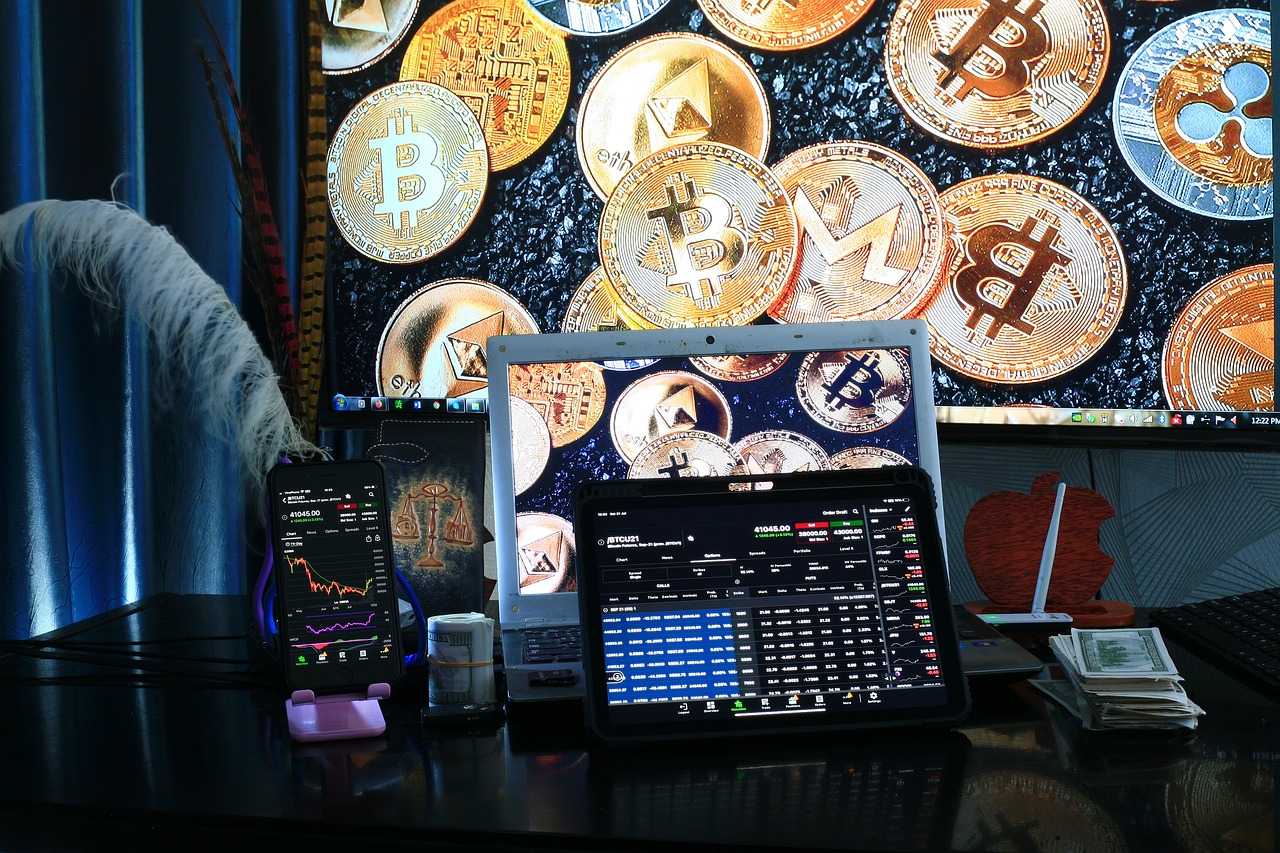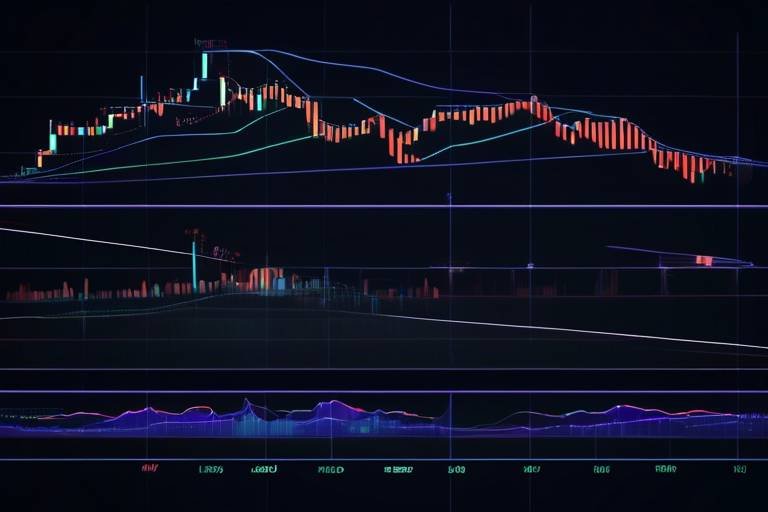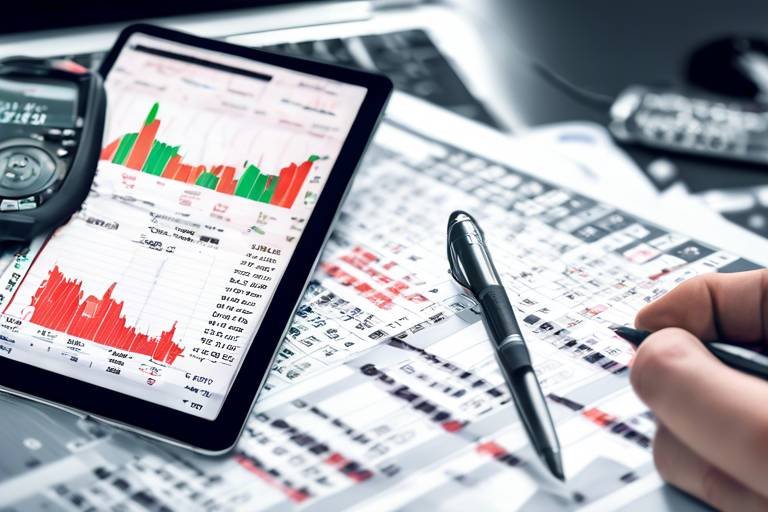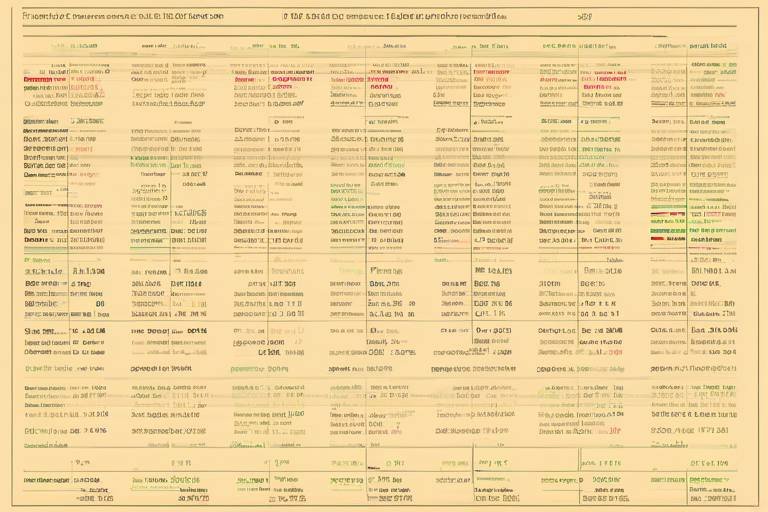Utilizing Trend Lines to Enhance Your Crypto Trading Strategy
In the fast-paced world of cryptocurrency trading, making informed decisions can feel like navigating a maze. Every twist and turn presents new challenges, and without the right tools, you might find yourself lost. This is where trend lines come into play. They are not just mere lines on a chart; they are powerful indicators that can help you decipher market movements and enhance your trading strategy. By understanding and utilizing trend lines effectively, you can improve your decision-making process and potentially increase your profitability. So, let’s dive into the fascinating world of trend lines and see how they can transform your trading game!
At its core, a trend line is a straight line that connects two or more price points and extends into the future, acting as a guide for traders. Think of it as a roadmap that helps you visualize the direction of the market. Trend lines can be drawn on any time frame, making them versatile tools for both short-term and long-term traders. By analyzing these lines, you can identify potential price movements, which can be crucial for making timely trades. Whether you're looking at daily charts or hourly charts, trend lines can help you spot trends that might otherwise go unnoticed.
There are three primary types of trend lines that every trader should be familiar with: upward trend lines, downward trend lines, and horizontal trend lines. Each type serves a unique purpose and can provide valuable insights into market behavior. Understanding these different trend lines is essential for developing a robust trading strategy.
Upward trend lines are drawn by connecting the lows of the price action, indicating a bullish market where prices are consistently rising. When you see an upward trend line, it’s like a green light signaling that the market is favoring buyers. But how do you draw and interpret these lines effectively? Start by identifying at least two significant lows on the chart, then connect them with a straight line. The more touchpoints you have, the stronger the trend line becomes. This can help you make informed decisions about when to enter or exit a trade.
Support levels are crucial in upward trends, as they indicate where prices may bounce back. Imagine a trampoline: when you jump down, it pushes you back up. Similarly, support levels act as a cushion for prices. To identify these levels using trend lines, look for areas where the price has historically bounced back. Drawing a horizontal line across these points can help you visualize potential support areas. This insight can be invaluable when determining your entry and exit points.
Finding optimal entry points is like striking gold in the mining business; it can significantly enhance your returns. By using upward trend lines, you can identify promising entry points in crypto trading. Look for price pullbacks towards the trend line, as these often present excellent buying opportunities. If the price touches the trend line and bounces back, it could be a signal to enter a trade. Remember, timing is everything, and using trend lines can help you get in at just the right moment.
On the flip side, downward trend lines signify a bearish market, where prices are on a decline. Drawing these lines involves connecting the highs of the price action. When you see a downward trend line, it’s a warning sign that the market may not be in your favor. Just like upward trends, downward trends can help you identify potential exit points. If prices consistently hit the downward trend line and fail to break through, it could be an indication to sell or short the asset.
To take your trading strategy to the next level, consider integrating trend lines with other technical indicators. This combination can provide a more comprehensive market analysis. For instance, using trend lines alongside moving averages can help confirm trends and signals. If both indicators align, it can provide a stronger case for making a trade. Additionally, incorporating the Relative Strength Index (RSI) can help you identify overbought or oversold conditions, giving you an edge in your trading decisions.
Moving averages smooth out price data to identify the direction of the trend. When used alongside trend lines, they can provide additional insights. For example, if the price is above both the upward trend line and the moving average, it may signal a strong bullish trend. Conversely, if the price is below both, it could indicate a bearish trend. By analyzing these two tools together, you can gain a clearer picture of market dynamics.
The RSI is a popular momentum indicator that can help you gauge whether an asset is overbought or oversold. When combined with trend lines, the RSI can enhance your trading strategy. For instance, if the price is touching a downward trend line and the RSI indicates that the asset is overbought, it might be a good time to consider selling. Understanding how these tools interact can lead to more informed trading decisions.
- What are trend lines? Trend lines are straight lines that connect price points on a chart, helping traders identify market direction.
- How do I draw a trend line? Identify significant highs or lows on the chart and connect them with a straight line.
- Why are trend lines important? They help traders visualize market trends, identify potential entry and exit points, and make informed decisions.
- Can trend lines be used in any market? Yes, trend lines can be applied to any financial market, including stocks, forex, and cryptocurrencies.

Understanding Trend Lines
Trend lines are like the compass of the trading world, guiding traders through the often turbulent waters of the cryptocurrency market. They are essential tools in technical analysis, providing a visual representation of price movements over time. But what exactly are trend lines? In simple terms, they are straight lines drawn on a price chart that connect significant price points, helping traders identify the general direction of an asset's price. Whether the market is soaring or plummeting, trend lines can help you make sense of the chaos and reveal potential trading opportunities.
To effectively utilize trend lines, traders need to understand how to draw them correctly. A trend line is typically drawn by connecting at least two price points. In an upward trend, the line connects the lows of the price action, while in a downward trend, it connects the highs. This connection creates a visual path that traders can follow to predict future price movements. But hold on a second—it's not just about drawing lines; it's also about interpreting them. Recognizing the slope of the trend line can offer insights into the strength of the trend. A steep slope indicates a strong trend, while a gentle slope suggests a weaker trend. Therefore, understanding the nuances of trend lines is crucial for making informed trading decisions.
Moreover, trend lines can also help traders identify key levels of support and resistance. Support levels are price points where an asset tends to stop falling and may even bounce back up, while resistance levels are where prices tend to stop rising and may reverse downward. By drawing trend lines, traders can better visualize these levels, enabling them to make more strategic decisions. For instance, if a trader notices that the price consistently bounces off a particular upward trend line, they might view this as a strong support level, indicating a good opportunity to enter a trade.
In the world of crypto trading, where volatility reigns supreme, trend lines can serve as a safety net. They help traders avoid emotional decision-making by providing a clear framework for analysis. Instead of relying on gut feelings, traders can refer to their trend lines to guide their actions. This methodical approach can significantly enhance trading strategies and lead to better decision-making and profitability.
In summary, understanding trend lines is pivotal for anyone serious about crypto trading. They are not just lines on a chart; they are powerful tools that can provide insights into market behavior and help traders navigate the ups and downs of the market. By mastering the art of drawing and interpreting trend lines, traders can enhance their strategies and ultimately improve their chances of success in the fast-paced world of cryptocurrency.

Types of Trend Lines
When diving into the world of crypto trading, understanding trend lines is crucial for anyone looking to make informed decisions. These lines serve as a visual representation of market sentiment and price movement, helping traders navigate the often turbulent waters of cryptocurrency markets. There are three primary types of trend lines that traders utilize: upward trend lines, downward trend lines, and horizontal trend lines. Each type plays a unique role in technical analysis, and knowing how to interpret them can significantly enhance your trading strategy.
Upward trend lines are drawn by connecting a series of higher lows, indicating that the price is on an upward trajectory. This type of trend line suggests a bullish market where traders are generally optimistic about future price increases. In contrast, downward trend lines connect a series of lower highs, indicating a bearish market where prices are declining. These lines help traders identify potential resistance levels where the price may struggle to rise. Lastly, horizontal trend lines are drawn when the price moves within a defined range, indicating a period of consolidation. These lines are essential for identifying potential breakout points.
Understanding the significance of each trend line type can greatly impact your trading decisions. For instance, when the price is consistently bouncing off an upward trend line, it may signal a good buying opportunity. Conversely, if the price is repeatedly hitting a downward trend line, it could be a warning sign to sell or short the asset. To illustrate this, let's break down the characteristics of each trend line type in the table below:
| Type of Trend Line | Indication | Market Sentiment |
|---|---|---|
| Upward Trend Line | Higher lows | Bullish |
| Downward Trend Line | Lower highs | Bearish |
| Horizontal Trend Line | Price consolidation | Neutral |
Incorporating these trend lines into your trading strategy can provide a clearer picture of market dynamics. For example, when combined with volume analysis, upward trend lines can confirm strong buying interest, while downward trend lines can signal a lack of demand. This synergy can enhance your ability to make timely and profitable trading decisions.
Ultimately, mastering the types of trend lines is about more than just drawing lines on a chart; it's about developing an intuitive understanding of market behavior. As you gain experience, you'll find that these lines can act as your compass, guiding you through the complexities of crypto trading and helping you navigate toward profitable opportunities.

Upward Trend Lines
When it comes to navigating the wild waters of the crypto market, serve as a beacon of hope for traders looking to capitalize on bullish movements. These lines are drawn by connecting the lows of a price chart, creating a visual representation of a market that is on the rise. Imagine standing on a hill, watching the sun rise over the horizon; that's the kind of optimism upward trend lines can inspire in your trading strategy. But how do you draw them, and what do they really mean?
To effectively draw an upward trend line, you need to start with at least two significant price points where the asset's price has bounced off a low. The more points you connect, the stronger the trend line becomes. A well-drawn upward trend line indicates that buyers are consistently stepping in at higher price levels, signaling a potential for continued growth. This is crucial for traders who want to ride the wave of rising prices, as it can help them make informed decisions about when to enter or exit a position.
But wait, there's more! Understanding how to interpret these lines is just as important as drawing them. An upward trend line not only indicates a bullish market but also provides traders with valuable insights into support levels. When prices approach the trend line, it often serves as a magnet, pulling them back up, much like a rubber band snapping back into place. This behavior can help you identify potential buy signals, as prices may bounce off the trend line and continue their upward trajectory.
Now, let's take a moment to consider the importance of identifying support levels. These levels are critical in an upward trend because they indicate where prices may bounce back after a dip. To identify support levels using trend lines, traders look for areas where the price has previously reversed direction. The more times a price touches the trend line without breaking through, the stronger the support level becomes. This is where your trading strategy can really shine. By entering a position near the support level, you can potentially maximize your gains while minimizing your risks.
So, how can you find those optimal entry points using upward trend lines? One effective strategy is to look for price retracements that touch or come close to the trend line. When this happens, it’s like finding a hidden treasure on a map; it signals a potential buying opportunity. Traders often use candlestick patterns in conjunction with these trend lines to confirm their entry points. For instance, if you see a bullish engulfing pattern forming near the trend line, it could be the green light you’ve been waiting for!
In summary, upward trend lines are not just lines on a chart; they are powerful tools that can guide your trading decisions. By understanding how to draw and interpret these lines, identifying support levels, and finding optimal entry points, you can enhance your crypto trading strategy significantly. Remember, the key is to stay vigilant and always look for those signals that indicate where the market is heading. Now, let’s dive deeper into how downward trend lines can play a role in your trading journey!
- What is an upward trend line? - An upward trend line is a straight line that connects the lows of an asset's price, indicating a bullish market where prices are rising.
- How do I draw an upward trend line? - To draw an upward trend line, connect at least two significant price lows on a chart. The more points you connect, the stronger the trend line.
- What does it mean if the price touches the trend line? - If the price touches the trend line, it may indicate a potential support level where the price could bounce back up.
- How can I use upward trend lines for trading? - Traders can use upward trend lines to identify potential entry points, especially when prices retrace to the trend line.

Identifying Support Levels
When diving into the world of crypto trading, one of the most vital concepts to grasp is the idea of support levels. These are price points on a chart where a cryptocurrency tends to stop falling and may even bounce back upwards. Imagine a trampoline; when you jump down, the trampoline provides support, pushing you back up. In trading, support levels serve a similar purpose, acting as a safety net for prices. Identifying these levels can significantly improve your trading strategy, allowing you to make more informed decisions.
To effectively identify support levels, traders often use trend lines along with historical price data. A common approach is to look for areas where the price has previously bounced back multiple times. The more often a price level has acted as a support, the stronger it is considered. This is because many traders remember these levels, and when the price approaches them again, they are likely to buy, believing the price will rise once more. It’s like a well-trodden path in a forest; the more people walk it, the clearer it becomes.
Here's a simple way to visualize how to identify support levels:
| Criteria | Description |
|---|---|
| Price History | Look for historical price points where the price has reversed direction multiple times. |
| Volume | Higher trading volume at a support level can indicate stronger support. |
| Time Frame | Support levels can vary across different time frames; longer time frames often provide stronger support. |
Additionally, incorporating other indicators can further validate your identified support levels. For instance, if a support level aligns with a moving average or a Fibonacci retracement level, it adds an extra layer of confidence to your analysis. Think of it as stacking building blocks; each additional indicator reinforces the structure, making it less likely to topple over.
In summary, identifying support levels is a critical skill for any crypto trader. By understanding where these levels lie and how to interpret them, you can better position yourself to make profitable trades. Remember, just like any other skill, it takes practice and experience to master. So, keep your charts open, stay observant, and watch how the price interacts with these crucial levels!
- What are support levels? Support levels are price points where a cryptocurrency tends to stop falling and may bounce back upwards.
- How do I identify support levels? Look for historical price points where the price has reversed direction multiple times, and consider the volume and time frame.
- Why are support levels important in trading? They help traders make informed decisions about when to buy or sell, potentially improving profitability.

Using Upward Trends for Entry Points
When it comes to crypto trading, identifying the right entry point can be the difference between a profitable trade and a costly mistake. Upward trend lines serve as a beacon for traders, illuminating potential entry points that could lead to significant profits. But how do you leverage these upward trends effectively? Let's break it down.
To start, you need to understand that an upward trend line is drawn by connecting a series of higher lows. This means that as the price moves up, it creates a pattern that traders can follow. By drawing this line, you can visualize the overall trajectory of the market. Now, imagine standing on a hill, looking down at a winding road; that road represents your upward trend line, guiding you towards your next move.
Once you've established your upward trend line, the next step is to look for entry points. These are typically found near the trend line itself. When the price approaches the trend line, it often indicates a potential bounce back, creating a perfect opportunity for traders to enter the market. Here are a few strategies to consider:
- Wait for a Bounce: When the price touches the trend line and begins to rise again, it’s a strong signal to consider entering the trade.
- Look for Volume Confirmation: Higher trading volume during a bounce can validate the strength of the trend, making it a more reliable entry point.
- Set Stop Losses: To manage risk, always set stop losses just below the trend line. This way, if the market unexpectedly turns against you, your losses will be minimized.
Additionally, it's crucial to monitor other market indicators while using upward trend lines for entry points. For instance, if the Relative Strength Index (RSI) indicates that the asset is oversold, this could further confirm that the price is likely to rise after touching the trend line. Think of it like a spring; when compressed, it’s poised to bounce back with greater force. Combining the upward trend line with RSI can give you a more robust picture of market conditions.
Finally, don't forget to keep an eye on market news and events that may influence price movements. Sometimes, external factors can lead to price spikes or drops that deviate from the trend. By staying informed, you can make better decisions about when to enter or exit trades.
In conclusion, using upward trend lines for entry points requires a blend of technical analysis and market awareness. By identifying these key levels and combining them with other indicators, you can enhance your trading strategy and increase your chances of making profitable trades.
Q: How do I draw an upward trend line?
A: Connect at least two higher lows on the price chart to create your upward trend line.
Q: What if the price breaks below the trend line?
A: This could indicate a reversal, and you may want to reconsider your position or set a stop loss.
Q: Can I use trend lines on any time frame?
A: Yes, trend lines can be applied to any time frame, but they may yield different results based on the volatility of the asset.

Downward Trend Lines
When it comes to navigating the tumultuous waters of the crypto market, serve as a beacon for traders looking to make sense of price declines. A downward trend line is drawn by connecting the highs of price movements, effectively illustrating a market that is in a state of decline. This line not only highlights the general direction of the market but also acts as a crucial tool for identifying potential selling opportunities. Understanding how to draw and interpret these lines can significantly enhance your trading strategy, allowing you to make more informed decisions.
To draw a downward trend line, you start by identifying at least two or more significant peaks in the price chart. Once you've pinpointed these peaks, simply connect the dots with a straight line. This line will slope downwards, indicating a bearish sentiment in the market. But don’t just stop there; interpreting the trend line is equally important. A consistent decline in price suggests that the market is losing momentum, which may lead to further drops. However, keep an eye out for potential reversals, as markets can be unpredictable.
One of the key advantages of utilizing downward trend lines is their ability to help traders identify resistance levels. Resistance levels are price points where the market has historically struggled to rise above. By observing where the price repeatedly hits the downward trend line, traders can gauge when to enter or exit positions. When the price approaches this line, it often signals a good opportunity to sell, as the likelihood of a price reversal is high. In this way, downward trend lines not only provide insights into market direction but also help in timing trades effectively.
Moreover, incorporating downward trend lines into your trading strategy can reveal critical entry and exit points. For instance, if you notice that the price is approaching the downward trend line and shows signs of weakening momentum, it might be a signal to short sell or take profits on existing long positions. But remember, while these lines are powerful tools, they should not be used in isolation. Always consider other market indicators and trends to validate your trading decisions.
In summary, downward trend lines are invaluable in the world of crypto trading. They help traders identify bearish trends, pinpoint resistance levels, and strategize their entry and exit points effectively. By mastering the art of drawing and interpreting these lines, you can enhance your trading strategy and make more informed decisions in an ever-changing market.
- What is a downward trend line?
A downward trend line is a line drawn on a price chart that connects the highs of declining prices, indicating a bearish market. - How do I identify a downward trend line?
To identify a downward trend line, look for at least two significant peaks in the price chart and connect them with a straight line. - Why are downward trend lines important?
They help traders identify potential selling opportunities and resistance levels, allowing for better decision-making. - Can I use downward trend lines alone?
While useful, it's best to combine trend lines with other indicators for a more comprehensive analysis.

Combining Trend Lines with Other Indicators
When it comes to enhancing your crypto trading strategy, combining trend lines with other technical indicators can be a game-changer. Imagine trend lines as the backbone of your analysis, providing the structure, while other indicators add the flesh, giving you a complete picture of market movements. By integrating these tools, you can significantly improve your decision-making process and increase your chances of profitability.
One of the most effective combinations is using trend lines with moving averages. Moving averages smooth out price data by creating a constantly updated average price, which helps to filter out the noise from random price fluctuations. When you overlay moving averages on your trend lines, you can identify key points where the price tends to react, such as areas of support and resistance. This can be particularly useful during volatile market conditions, as it provides additional confirmation of price trends. For instance, if the price is above both the upward trend line and the moving average, it may signal a strong bullish trend.
Another powerful tool to consider is the Relative Strength Index (RSI). The RSI is a momentum oscillator that measures the speed and change of price movements. By using the RSI in conjunction with trend lines, you can pinpoint overbought or oversold conditions in the market. For example, if the RSI indicates that an asset is overbought while the price is approaching a downward trend line, it may be a signal to sell or short the asset. Conversely, if the RSI shows an oversold condition and the price is bouncing off an upward trend line, it could be a great opportunity to buy.
To illustrate these concepts, let’s look at a simple example:
| Indicator | Signal | Action |
|---|---|---|
| Upward Trend Line | Price bouncing off the line | Consider buying |
| Moving Average | Price above the moving average | Strong bullish signal |
| RSI | RSI below 30 | Potential buying opportunity |
Incorporating these indicators not only provides a more comprehensive view of the market but also allows for more informed trading decisions. It's like having a map and a compass; while the trend lines guide you through the terrain, the moving averages and RSI help you navigate tricky situations. Remember, the key is to look for confluence—where multiple indicators align to provide a stronger signal. This approach can greatly enhance your trading strategy, making it more robust and reliable.
- What are trend lines? Trend lines are straight lines drawn on a chart that connect price points, indicating the direction of price movement.
- How do I draw a trend line? To draw a trend line, connect at least two price points on a chart, ensuring the line follows the general direction of the price movement.
- Can trend lines be used in all markets? Yes, trend lines can be applied to any financial market, including stocks, forex, and cryptocurrencies.
- What is the best way to combine trend lines with other indicators? Look for areas where trend lines intersect with indicators like moving averages or RSI to confirm potential trading signals.

Moving Averages and Trend Lines
When it comes to enhancing your crypto trading strategy, combining moving averages with trend lines can be a game changer. Think of moving averages as the steady hand on the wheel, guiding you through the volatile seas of cryptocurrency trading, while trend lines act as your navigational charts, helping you identify the direction of the market. Together, they create a powerful synergy that can lead to more informed trading decisions.
To start, let's break down what moving averages are. A moving average smooths out price data by creating a constantly updated average price. This is particularly useful in the crypto market, where prices can swing wildly within short periods. By looking at moving averages, you can filter out the noise and focus on the underlying trend. The two most common types are the Simple Moving Average (SMA) and the Exponential Moving Average (EMA). While the SMA gives equal weight to all prices, the EMA gives more weight to recent prices, making it more responsive to new information.
Now, how do we effectively combine these with trend lines? Let’s say you’ve identified an upward trend line. You can draw a moving average line above or below this trend line to gauge the momentum of the price movement. If the price consistently stays above the moving average, it signals a strong bullish trend. Conversely, if the price dips below the moving average, it might indicate a potential reversal or correction. This is where the magic happens: using the intersection of moving averages and trend lines can help you pinpoint potential entry and exit points.
For example, consider the following scenario:
| Market Condition | Price Action | Moving Average Position | Trading Decision |
|---|---|---|---|
| Uptrend | Price above trend line | Moving average below price | Consider buying |
| Downtrend | Price below trend line | Moving average above price | Consider selling |
| Sideways | Price fluctuating around trend line | Moving average flat | Hold or wait for clearer signals |
By observing these conditions, you can make more calculated decisions. Additionally, traders often use a crossover strategy, where they look for points where a shorter-term moving average crosses a longer-term moving average in relation to the trend line. For instance, if a short-term EMA crosses above a long-term SMA while both are above an upward trend line, it may signal a strong buy opportunity.
However, it’s important to remember that no strategy is foolproof. Always consider market conditions, news events, and other factors that can influence price movements. Moreover, backtesting your strategies with historical data can provide valuable insights into their effectiveness. By combining moving averages with trend lines, you not only enhance your analysis but also increase your chances of making profitable trades.
- What are moving averages? Moving averages are indicators that smooth out price data to identify trends over a specific period.
- How do I choose between SMA and EMA? If you want a smoother indicator that is less responsive to price changes, use SMA. For a more reactive indicator, opt for EMA.
- Can trend lines be used alone? While trend lines can provide valuable insights, combining them with other indicators like moving averages can lead to better trading decisions.
- What should I do if the price breaks a trend line? A break could indicate a reversal or continuation of the trend. Always look for confirmation from other indicators before making a decision.

Relative Strength Index (RSI) and Trend Lines
The Relative Strength Index (RSI) is a powerful momentum indicator that traders often use to gauge the strength of a trend. When combined with trend lines, the RSI can provide deeper insights into market conditions, helping traders make more informed decisions. Imagine you're navigating a ship through turbulent waters; the RSI acts as your compass, guiding you through the waves of price fluctuations while the trend lines serve as the shoreline, indicating where you might land safely.
One of the most effective ways to utilize the RSI with trend lines is to identify overbought or oversold conditions in the market. The RSI operates on a scale from 0 to 100, with readings above 70 typically indicating an overbought condition and readings below 30 suggesting an oversold condition. By drawing trend lines on your price charts and observing the RSI levels, you can better understand potential reversal points. For example, if the price is trending upwards and the RSI reaches above 70, it may signal that the trend is losing momentum, hinting at a potential pullback.
To illustrate this concept further, consider the following table that summarizes the relationship between RSI levels and trend line analysis:
| RSI Level | Market Condition | Actionable Insight |
|---|---|---|
| Above 70 | Overbought | Consider selling or taking profits |
| Between 30 and 70 | Neutral | Hold position or wait for further signals |
| Below 30 | Oversold | Consider buying or entering a position |
In addition to identifying overbought and oversold conditions, the RSI can help confirm trend line breaks. For instance, if a downward trend line is broken and the RSI moves above 30, it could indicate that the market is shifting from a bearish to a bullish sentiment. This convergence of signals can be a strong indicator for traders to enter a position. Conversely, if the price breaks a support trend line while the RSI remains below 30, it may suggest continued weakness, prompting traders to reassess their positions.
Ultimately, the synergy between the RSI and trend lines provides traders with a robust framework for analyzing market dynamics. By keeping an eye on both indicators, you can enhance your trading strategy and improve your chances of success. Just like a seasoned sailor uses both the compass and the stars to navigate, combining these tools can lead you to safer and more profitable trading waters.
- What is the best RSI level to use for trading? The commonly accepted levels are 70 for overbought and 30 for oversold conditions, but it's essential to consider the context of the market.
- How often should I check the RSI? It's a good practice to review the RSI regularly, particularly when entering or exiting trades, to ensure you're aware of current market conditions.
- Can trend lines be used in all markets? Yes, trend lines can be applied across various markets, including stocks, forex, and cryptocurrencies.
Frequently Asked Questions
- What are trend lines in crypto trading?
Trend lines are straight lines that connect two or more price points on a chart, helping traders visualize the direction of the market. They are essential for identifying potential price movements and making informed trading decisions.
- How do I draw an upward trend line?
To draw an upward trend line, identify at least two significant price lows on a chart. Connect these points with a straight line, extending it into the future. This line indicates support levels where prices might bounce back, signaling a bullish trend.
- What is the significance of support levels?
Support levels are crucial in upward trends as they represent price points where buying interest is strong enough to overcome selling pressure. Identifying these levels helps traders anticipate potential price rebounds, enhancing their trading strategies.
- Can trend lines be combined with other indicators?
Absolutely! Combining trend lines with other technical indicators like moving averages and the Relative Strength Index (RSI) can provide a more comprehensive market analysis. This integration helps traders make better-informed decisions.
- How do moving averages enhance trend line analysis?
Moving averages smooth out price data to identify the overall trend direction. When used alongside trend lines, they can confirm trade signals and provide additional insights into potential price movements, making your analysis more robust.
- What role does the RSI play in conjunction with trend lines?
The RSI is a momentum indicator that helps determine overbought or oversold conditions in the market. When combined with trend lines, it can signal potential reversals, allowing traders to make timely entry or exit decisions.
- Are there any risks associated with using trend lines?
Yes, while trend lines can be powerful tools, they are not foolproof. Market conditions can change rapidly, and relying solely on trend lines without considering other factors can lead to losses. It's essential to use them as part of a broader trading strategy.



















